The breakwater is located at the periphery of the port water area, which is to prevent the harbor basin from silting up and the shoreline from being eroded by waves under the action of waves and tidal currents on sandy and muddy coasts. It is also necessary to prevent ice intrusion and ensure that there is sufficient water depth and stable water surface in the port to meet the requirements of ships berthing, loading and unloading, sailing and other requirements in the port. The hydraulic structures built are an important part of transport and harbor engineering.
The breakwater is divided into two types according to its layout shape: a breakwater connected to the shore and an island breakwater not connected to the shore; According to the section form, it can be divided into mound breakwater, vertical breakwater, composite breakwater, permeable breakwater, floating breakwater, pneumatic breakwater and hydraulic breakwater.
Function
1 Defending against the attacks of waves and ice, ensuring the stability of the harbor water area, and providing safe berthing and operating conditions for ships.
2 Sand or muddy coasts have active sediment, reducing or preventing mud and sand, reducing sedimentation in the port waters, and ensuring that the water depth in the port waters is navigable.
3 The inner side of the embankment can also serve as a dock or place anchoring equipment for ships to dock, load and unload, etc.
Classification
1 Divided by plane layout
① Single jetty: One end is connected to the shore, and the other end extends into the sea.
② Double jetty: A breakwater extends from each of the two coastal areas into the sea, forming a doorway shape at the end.
③ Freestanding: Both ends are not connected to the shore and are located in water at a certain distance from the shore. There is no embankment root, only the head and body of the embankment, shaped like an island, often mixed with the jetty to form multiple entrances.
2 Divided by section form
① Mound breakwater
Its cross-section is trapezoidal, made by throwing stones or various forms of concrete blocks, which can better adapt to the deformation of weak foundations. The outer embankment slope can directly withstand wave action and reduce the energy of incoming waves, and large stones are used within the range of wave amplitude to prevent wave damage. The design of the inner embankment slope is compatible with the waves in the harbor. Suitable for water areas with weak foundations, low water depth, and moderate wave intensity on muddy coasts.
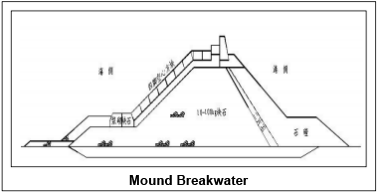
② Vertical breakwater
The concrete gravity vertical wall of the embankment body relies on its own weight to resist the impact of waves and maintain the stability of the wall body. Waves will reflect in front of the vertical wall to form standing waves. At that time, the vertical wall will withstand lateral standing wave pressure and bottom buoyancy. Therefore, a layer of crushed stone foundation bed is often placed under the vertical wall during construction to enhance the bearing capacity of the foundation. A wave wall is set outside the top of the wall to reduce the wave energy and effectively reduce the wave load and the weight of the wall body. The inside of the straight wall can also be used as a dock for ships. Suitable for bedrock or relatively dense foundations, as well as water bodies with large water depths.
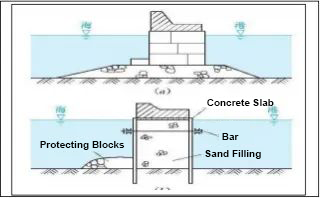
③ Composite breakwater
The lower part uses slope rockfill as the foundation, and the upper part is a concrete vertical wall structure, which is a combination of mound and vertical wall breakwaters. From low to high, the wave shape in front of the vertical wall will change from standing wave to broken standing wave, breaking wave, and after breaking wave to climbing water flow. When the foundation bed is high, a wave breaking occurs in front of the wall, and the maximum pressure on the wall is more than twice that of the standing wave. Its point of action will be higher than the static water level, directly affecting the stability of the wall. In practical applications, consideration should be given to the height of the foundation bed and the wave breaking load.
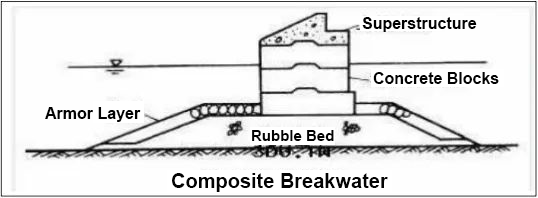
④ Permeable breakwater
Install wave dissipating structures on the top of pile groups or columns driven into the base, forming a permeable structure that allows waves to pass through the lower part of the breakwater. The characteristic of wave energy being concentrated on the surface is that the surface internal wave energy accounts for over 90% at a height of three times the wave height. Install a wave resistant structure wave box or baffle, with a height of two-thirds of the submerged water of the wave box or baffle. The outer side of the permeable embankment is used for wave protection, and the inner side can accommodate ships.
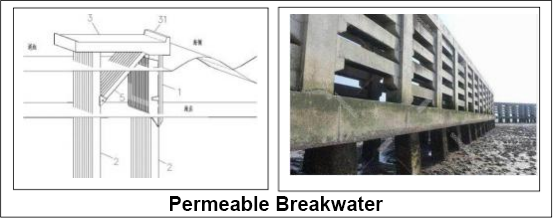
⑤ Floating breakwater
A type of breakwater that utilizes the interaction between waves and a floating body, causing the floating body to sway on the water surface. The vibration generated by the inertia of the floating structure reduces wave energy. The floating body has high mobility and can be moved, and the width of a single piece should not be too large. Sometimes, the floating embankment needs to be divided into several channels for installation,. Commonly used in lakes and reservoirs, floating embankments are more suitable for reservoirs with large water depths and can withstand smaller waves.
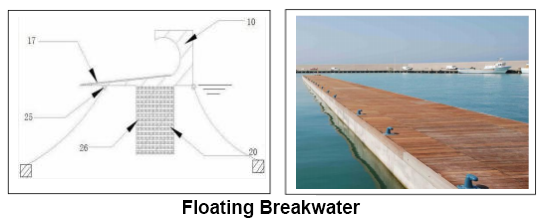
⑥ Pneumatic breakwater and hydraulic breakwater
The pneumatic breakwater uses an air compressor to spray air through perforated pipes placed at the bottom of the water, forming an air curtain and circulation on both sides, hindering and reducing waves. The hydraulic breakwater uses a water pump to spray water through a nozzle placed on the water surface, in order to reduce wave energy. Both are easy to move and are commonly used in temporary projects.
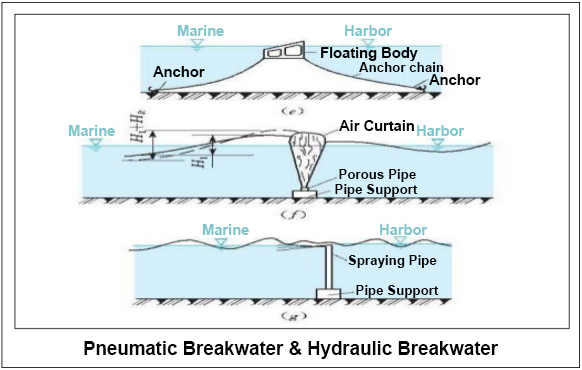
Ningbo Xiaolang Construction Engineering Co., Ltd.
Ningbo Tianyuan Cement Products Co., Ltd.
Yuehu Ginza, Nanzhan East Road, Haishu District, Ningbo City
+86 574 8698 8331
315012


Copyright © Ningbo Tianyuan Construction Engineering Co., LTD All Rights Reserved | Sitemap
